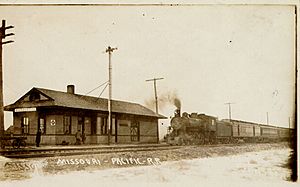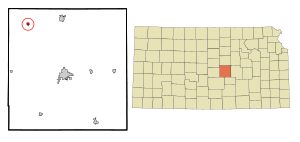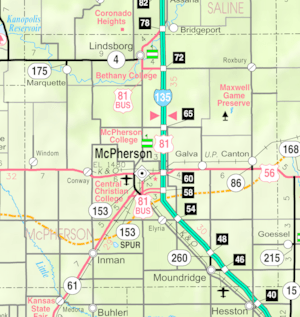Marquette, Kansas facts for kids
Quick facts for kids
Marquette, Kansas
|
|
|---|---|

Marquette's Missouri Pacific Railroad stop at the turn of the twentieth century
|
|

Location within McPherson County and Kansas
|
|

|
|
| Country | United States |
| State | Kansas |
| County | McPherson |
| Founded | 1874 |
| Incorporated | 1874 |
| Named for | Marquette, Michigan |
| Government | |
| • Type | Mayor–Council |
| Area | |
| • Total | 0.48 sq mi (1.25 km2) |
| • Land | 0.48 sq mi (1.25 km2) |
| • Water | 0.00 sq mi (0.00 km2) |
| Elevation | 1,391 ft (424 m) |
| Population
(2020)
|
|
| • Total | 599 |
| • Density | 1,248/sq mi (479.2/km2) |
| Time zone | UTC-6 (CST) |
| • Summer (DST) | UTC-5 (CDT) |
| ZIP code |
67464
|
| Area code | 785 |
| FIPS code | 20-44925 |
| GNIS ID | 2395018 |
Marquette is a small city in McPherson County, Kansas, United States. In 2020, about 599 people lived there. It is located near K-4 and the Smoky Hill River.
Contents
History of Marquette
For thousands of years, the land that is now Kansas was home to Native American tribes. In 1803, the United States gained most of modern Kansas through the Louisiana Purchase. This was a huge land deal with France.
In 1854, the Kansas Territory was created. Then, in 1861, Kansas became the 34th U.S. state. McPherson County was officially started in 1867.
Founding the City
Marquette began in 1873 with a flour mill by the Smoky Hill River. The town was officially started on February 9, 1874. Many early settlers were Swedish immigrants and Civil War veterans. The city was named after Marquette, Michigan. It was also located along the Missouri Pacific Railroad line.
Tornadoes in Marquette
On May 8–9, 1905, a very strong tornado hit Marquette. It destroyed much of the town and caused many deaths. Many homes were completely swept away.
Another powerful tornado, an EF4, passed west of Marquette on April 14, 2012. It swept away a home near Langley, leaving only its foundation. Luckily, no one was hurt or killed in this storm.
Geography and Climate
Marquette is found in the Smoky Hills area of Kansas. This region is known for its unique rock formations. These are made of Cretaceous-era sandstone called the Dakota Formation. Over time, erosion has shaped these rocks into hills and buttes. These rise sharply from the flat plains around them.
According to the United States Census Bureau, Marquette covers about 0.44 square miles (1.14 square kilometers). All of this area is land.
Marquette's Climate
The weather in Marquette has hot, humid summers. Winters are generally mild to cool. The area has a humid subtropical climate. This means it gets plenty of rain and has warm temperatures for much of the year.
Population and Growth
| Historical population | |||
|---|---|---|---|
| Census | Pop. | %± | |
| 1890 | 367 | — | |
| 1900 | 489 | 33.2% | |
| 1910 | 715 | 46.2% | |
| 1920 | 780 | 9.1% | |
| 1930 | 714 | −8.5% | |
| 1940 | 609 | −14.7% | |
| 1950 | 666 | 9.4% | |
| 1960 | 607 | −8.9% | |
| 1970 | 578 | −4.8% | |
| 1980 | 639 | 10.6% | |
| 1990 | 593 | −7.2% | |
| 2000 | 542 | −8.6% | |
| 2010 | 641 | 18.3% | |
| 2020 | 599 | −6.6% | |
| U.S. Decennial Census | |||
In 2003, Marquette started a special program. To help its population grow, the city offered free land to new residents. It was one of the first Kansas cities to do this. Other cities like Ellsworth and Kanopolis later started similar programs.
Fifty acres (about 200,000 square meters) of old farmland were prepared. They added gravel streets, water, electricity, and gas lines. In less than a year, 21 lots were claimed. To get the free land, people had to build a house within a year. They also had to live in that house for at least one year.
People in Marquette (2020)
The 2020 United States census showed that 599 people lived in Marquette. There were 274 households and 161 families. Most residents (about 95%) were white. A small number of people were from two or more races or other races. About 4% of the population was Hispanic or Latino.
About 25% of households had children under 18. The average household had 1.9 people. The average family had 2.3 people. The median age in the city was 50.5 years. This means half the people were older than 50.5 and half were younger.
Local Economy
Marquette's economy has been boosted by its unique program. The city offers free residential land to people who agree to build a home there. This has brought new residents to the town. They enjoy the quiet, small-town lifestyle. This program helps the community grow and thrive.
Attractions and Things to Do
Marquette's downtown area has a block of historic stores. These buildings are from the late 1800s. They have been restored and repainted to look like they did originally. This area is called the Washington Street Historic District. It is a state historic site.
Historic Homes and Museums
Nearby is the Hanson-Lindfors home. This large, sixteen-room Victorian style house was built in 1888. It is named after Hans Hanson, one of the city's founders. The house has been restored and is listed on the National Register of Historic Places. In the backyard, you can find Hanson's original 1871 wood cabin. The city's official charter was signed in this cabin.
The downtown area also has the Range School Museum. This was a one-room schoolhouse built in 1906. It was moved to its current spot about 80 years later. Each spring and fall, local students get to experience a half-day of class in this historic school.
The Kansas Motorcycle Museum is located downtown on North Washington Street. It was started in 2004 by "Stan the Man" Engdahl. He was a national racing champion and grew up in Marquette.
Outdoor Adventures
About ten miles away is Kanopolis State Park. This was the first state park in Kansas. The park was finished in 1948. It has over 22,000 acres (89 square kilometers) of hills, bluffs, and woods. There is also a 3,000-acre (12 square kilometers) lake.
The park offers many outdoor activities. These include hunting, fishing, and over 25 miles (40 kilometers) of trails. You can find animals like pheasants, quail, prairie chickens, and deer. Fishing for white bass and crappie is also very popular.
Education in Marquette
The community is part of the Smoky Valley USD 400 public school district. Students in this district attend Smoky Valley High School. Their mascot is the Smoky Valley Vikings.
Marquette High School used to be in the city. Its mascot was the Marquette Wolverines. However, it closed in 1985 due to school unification. On June 7, 2014, the last school building in Marquette closed its doors. This happened because of funding issues from the school district.
Images for kids
-
Marquette grain elevator
See also
 In Spanish: Marquette (Kansas) para niños
In Spanish: Marquette (Kansas) para niños













